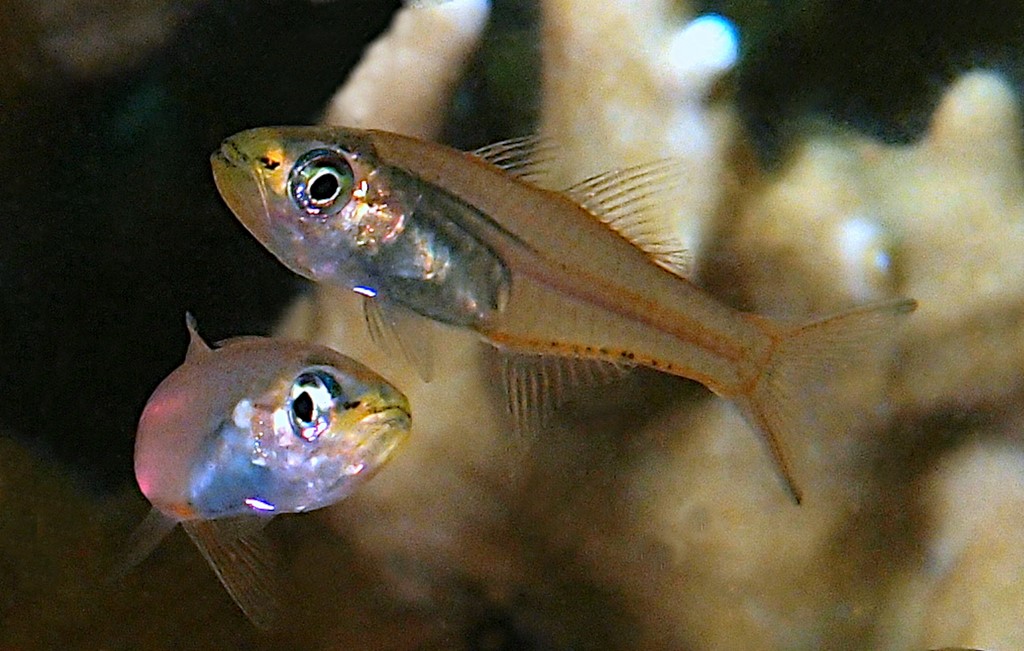VERULUX CYPSELURUS - (WEBER, 1909)
Actinopterygii (Gigaclass) > Actinopteri (Class) > Teleostei (Subclass) > Gobiiformes (Order) > Apogonoidei (Suborder) > Apogonidae (Family) > Apogoninae (Subfamily) > Verulux (Genus)
Apogon à queue d'hirondelle, Schooling cardinalfish, Black-nosed cardinalfish, Swallowtail cardinalfish, Luminous cardinalfish, Nose-spot cardinalfish, Kurosuji-sukashitenjikudai, クロスジスカシテンジクダイ, 大目侧仔, 燕尾箭天竺鲷,
Synonymes
Rhabdamia cypselura (Weber, 1909)
Rhabdamia cypselurus (Weber, 1909)
----------------------
Description
Dorsal spines (total): 6; Dorsal soft (total): 1 spine, 9 rays; Anal spines: 2; Anal soft rays: 9; Pectoral fin rays: 14-16 (usually: 15); Developed gill rakers: 11-14 (usually: 13). Villiform teeth in one row on premaxillae, dentaries (and slightly enlarged near symphysis) and vomer, and absent or present in one row on palatines. Median predorsal scales: 4. Luminous organ under cleithrum. Max. length: 6.0 cm TL. Depth range: 2 - 50 m, usually: 2 - 15 m.
Color
Body translucent, abdomen and most of head iridescent silvery; Snout with black dash between upper jaw and eye; Tips of jaws blackish, sides pale greenish or yellowish; Tiny spots on nape and dorsum to second dorsal fin; Median fins tinged pale red-orange; Caudal fin lobes each with darkish longitudinal stripe, inner and outer rays otherwise translucent.
Etymology
Verulux: from Latin, verū = spit, broach (esp. for roasting), dart, javelin + from Latin, lūx = light. Referring to body shape of Verulux cypselurus and referring to its auto-enzymatic bioluminescent organs.
cypselurus: from Latin, kypselos = swallow (bird) + from Greek, oura = tail. Referring to deeply forked caudal fin with pointed lobes, like that of a swallow.
Original description: Rhabdamia cypselurus Weber, 1909 - Type locality: Kawa, western Ceram (Seram), Maluku Province, Indonesia, Selat Boano/Strait of Boano, Seram Sea - 3°01'S, 128°04'E.
Distribution
Red Sea; Indo-West Pacific: East Africa, Persian Gulf, Socotra (Yemen), Comoros, Madagascar, Maldives and Chagos Archipelago, east to Marshall Islands, Fiji and Tonga, north to Japan, south to Western Australia and New Caledonia.
Biology
Found among rocks or above corals of lagoon patch reefs to outer reef drop-offs, usually adjacent to deep water with large coral heads. In cave during the day, forming dense schools. Spreads out at night, floating well above the substrate in pursuit of zooplankton. Distinct pairing during courtship and spawning.
Last update: 12, April 2023
Apogon à queue d'hirondelle, Schooling cardinalfish, Black-nosed cardinalfish, Swallowtail cardinalfish, Luminous cardinalfish, Nose-spot cardinalfish, Kurosuji-sukashitenjikudai, クロスジスカシテンジクダイ, 大目侧仔, 燕尾箭天竺鲷,
Synonymes
Rhabdamia cypselura (Weber, 1909)
Rhabdamia cypselurus (Weber, 1909)
----------------------
Description
Dorsal spines (total): 6; Dorsal soft (total): 1 spine, 9 rays; Anal spines: 2; Anal soft rays: 9; Pectoral fin rays: 14-16 (usually: 15); Developed gill rakers: 11-14 (usually: 13). Villiform teeth in one row on premaxillae, dentaries (and slightly enlarged near symphysis) and vomer, and absent or present in one row on palatines. Median predorsal scales: 4. Luminous organ under cleithrum. Max. length: 6.0 cm TL. Depth range: 2 - 50 m, usually: 2 - 15 m.
Color
Body translucent, abdomen and most of head iridescent silvery; Snout with black dash between upper jaw and eye; Tips of jaws blackish, sides pale greenish or yellowish; Tiny spots on nape and dorsum to second dorsal fin; Median fins tinged pale red-orange; Caudal fin lobes each with darkish longitudinal stripe, inner and outer rays otherwise translucent.
Etymology
Verulux: from Latin, verū = spit, broach (esp. for roasting), dart, javelin + from Latin, lūx = light. Referring to body shape of Verulux cypselurus and referring to its auto-enzymatic bioluminescent organs.
cypselurus: from Latin, kypselos = swallow (bird) + from Greek, oura = tail. Referring to deeply forked caudal fin with pointed lobes, like that of a swallow.
Original description: Rhabdamia cypselurus Weber, 1909 - Type locality: Kawa, western Ceram (Seram), Maluku Province, Indonesia, Selat Boano/Strait of Boano, Seram Sea - 3°01'S, 128°04'E.
Distribution
Red Sea; Indo-West Pacific: East Africa, Persian Gulf, Socotra (Yemen), Comoros, Madagascar, Maldives and Chagos Archipelago, east to Marshall Islands, Fiji and Tonga, north to Japan, south to Western Australia and New Caledonia.
Biology
Found among rocks or above corals of lagoon patch reefs to outer reef drop-offs, usually adjacent to deep water with large coral heads. In cave during the day, forming dense schools. Spreads out at night, floating well above the substrate in pursuit of zooplankton. Distinct pairing during courtship and spawning.
Last update: 12, April 2023
